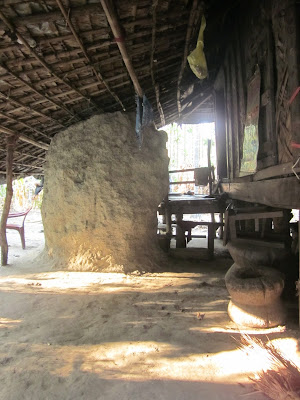Who is it that would live in a house full
of termites?
 |
| Termite mound under veranda roof. |
Away from the beach in Sabrang south of
Teknaf town, shady country laneways meander between household flower garden and
heavenly stand of areca palm. Adding a meditative symmetry of vertical lines to
the landscape, the areca plantations bring renowned to Teknaf, contributing to
the district’s areca nut fame. A few hundred metres short of the Naf River,
local conditions favour areca nut flavour and everybody knows.
 |
| Country laneway, Sabrang, Teknaf. |
In the calm, subtropical greenery, that
neighbourhood of rustic households built not only on areca but quite often on
remittance from labour migration as well, it’s easy to imagine that nature’s quiet
is humankind’s ultimate prosperity.
 |
| Areca palms. |
Yet it’s a locality that’s undergone
significant change, evidence of which can be found at the old pond in Bazar
Para. Flanked by two banyan trees, reminiscent of the fig under which Gautama
Buddha achieved enlightenment in India’s Bodh Gaya, Sabrang was once inhabited
by Buddhist Rakhines and the pond during the British era was the centre of
town. Nowadays its ghat is crumbled; the pond’s significance has faded into the
rural landscape. With just a few groceries stores Bazar Para is a market in
name only.
 |
| Areca palm plantation, Sabrang. |
“There used to be a Buddhist temple,” says
local Saifuddin Khaled, 41, “But when the Rakhines left for Myanmar the land
was eventually sold.” Where once Sabrang was ruled by Rakhine landlords, today
there are only two Rakhine families remaining.
The home of Mong Pru, 57, is of weathered
timber, raised on stilts as in Rakhine tradition. Pru has four daughters, two
married to jewellery technicians and his daughters sit upstairs on the old balcony
that slopes from age, passing a relaxing afternoon with household tailoring
work.
Pru says most of Sabrang’s Rakhines left
for Myanmar in the 1990s. “We had no land there,” he explains of his decision
to stay, “There was nothing to go to. We were very poor then.”
 |
| An old well in the yard of the termite house. |
Yet it’s not his house but that of his
neighbour, in a similar architectural style, which is unique in featuring a
termite mound in the middle of its veranda. Its current owner is also a
jewellery technician and his shy wife Lamia, who is originally from Royasanka
in Myanmar, has been in Bangladesh with her husband for fifteen years but is
not confident to speak Bangla.
 |
| The termite house, waiting for prosperity. |
 |
| The termite house. |
She does say that the termites don’t eat
the wooden house.
“The house is about 50 years old,” recalls
Pru, “And the termite mound was even taller when it was built.” They had to cut
the mound slightly to fit it under the veranda roof.
 |
| The yard of the termite house. |
At the time a Buddhist monk advised the
family not to break the termite mound. “If you let it grow it will bring you
prosperity,” the monk foretold. The termite mound is regarded as a blessing and
a place to offer prayer.
 |
| A Rakhine alphabet chart. |
“It’s always been there,” says one of Pru’s
daughters. “Now it’s mainly for beauty.”
 |
| The termite mound in the veranda area. |
And when it comes to prosperity it seems
that Pru’s neighbour is still waiting, although it’s not certain that they
weren’t poorer when the house was built. Or perhaps it’s a lesson that nature’s
quiet more than money is humankind’s ultimate prosperity.
 |
| Mong Pru, 57, with his grandson Owen Twey. |
Standing in the garden with his young
grandson Owen Twey in his arms, Pru is pleased his family didn’t follow the
other Rakhines across the Naf River. “In Myanmar there are too many problems,”
he says, “Life is better here.” His family like that of his neighbour is
counting on a peaceful and bright Bangladeshi future.
 |
| Two of Pru's daughters. |
 |
| Bazar Para pond. In the British period it was the centre of town. |
 |
| Bazar Para pond. |
This article is published in The Daily Star, here: Sabrang's Termite House and a Dream of Prosperity
 |
| Carving a traditional weight, for exercise. |

Really interesting post! The termite attack is very harmful for wood and plants. You know they spoiled my entire strawberry crop last year. But this year I hired Termite inspection Port Macquarie firm for the removal of all the pests from my garden.
ReplyDeleteThanks chrisshart. Sorry to hear about your strawberries.
DeleteNice post indeed!
ReplyDelete